History of Montvale
History of Montvale

Located eight miles from Maryville TN, Montvale Springs is nestled in the foothills of Chilhowee Mountain adjoining the Great Smoky Mountains National Park. The land sustained the indigenous peoples of this area for thousands of years. Settlers discovered Montvale’s mineral springs in 1832, and by the mid-1800’s Montvale Springs was the site of the 125-room Seven Gables Hotel which, at the height of its popularity became known as the Saratoga of the South where people from around the world came to take the healing, restorative waters found in the mineral springs. The original hotel was destroyed and rebuilt several times until it was once again destroyed by fire in 1933. In 1947, the property was sold to the YMCA for a summer camp that became a local institution, providing summer camp experiences for thousands of area children and youth until the camp closed in 2005.
Montvale’s future was uncertain when former Camp Montvale counselor Sam Furrow purchased the property in 2008 and subsequently gifted it to Harmony with a vision of preserving the property as a place for people of all ages to enjoy. Montvale has since been placed in a conservation easement that restricts usage to programming that benefits children, families, and the community.
Today, visitors will find a picturesque mountain retreat with cabins, a barn and stable, a beautifully renovated dining hall which can also be used for indoor meeting space, a 155,000-gallon pool, a 17-element challenge course, a climbing tower, numerous hiking trails, several open-air pavilions, basketball and sand volleyball courts, an athletic field, interactive playground, and more.
Since 2012, Harmony has utilized the property for therapeutic camps, retreats, and trainings. Private events held at Montvale allow Harmony to continue to fund and expand our therapeutic work with children, adults, and families and ensures that Montvale continues to be a place of healing for generations to come.
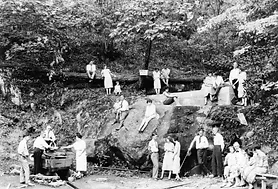
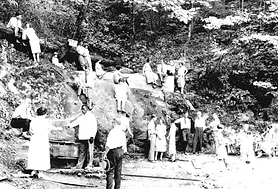
1832
The first hotel was built. Daniel Foute bought 6,300 acres of mountain land along the Chilhowee and into Cades Cove – including the black sulphur spring on the road to Montvale where he built a 10 room log hotel. It was Foute who laid out and built roads and trails using Cherokee Indian labor. He built a road from Maryville through Murray Gap to intersect with the Calloway-Parsons and Unicoi Turnpikes to Georgia and North Carolina. And he built the Cooper Road from Maryville to Cades Cove as well as the Foute Trail from Montvale through Happy Valley to Gregory’s Bald and back by way of the Cooper Road and Gold Creek to Look Rock.
Foute planted extensive vineyards and orchards and developed the springs – one source says the hotel was a few steps from two mineral springs (the Sweet William spring was higher on the mountain). By 1837 there was a stage line to Montvale from Knoxville by way of Maryville. The first novel published in Tennessee Woodville, by Tennessee novelist Charles Todd was written at this first hotel.

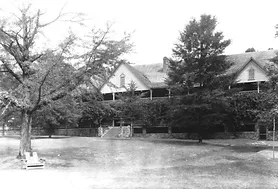
1850
Foute sold 3,840 acres to wealthy Mississippi planter and world traveler Asa Watson, and in 1853 Asa Watson razed the log hotel and constructed a much larger and more elegant three-story 125 room frame building with seven-gables, which gained fame as one of the largest in the southern mountains. The hotel was two hundred feet long with large porches wrapped around all three floors; he also built 60 cottages – some for servants of the 300-400 guests. An extensive 10-20 acre lawn formed the grounds with some 60 rare trees Watson imported from Japan and California; several of these trees stand on the grounds today (cypress, gingko, incense cedar, scotch broom, pawlonia).

1855
At the peak of its popularity The Montvale Springs Hotel was the leading antebellum mineral springs resort in East Tennessee and the only major resort hotel built in the mountains of Blount County prior to the Civil War. At the height of its popularity guests came from across the nation to escape heat and disease and to drink the mineral waters of the springs – some spending their entire summers with families and servants, and by mid-century the hotel had become known as the Saratoga of the South. Rates for room and board: $2 per day; $12 per week; $40 per month.
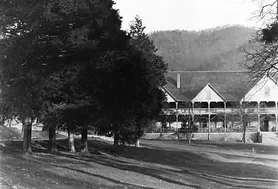
1858
Sterling Lanier, grandfather to the famed Southern poet Sidney Lanier, and his family purchased the hotel and its 4,500 acres for $25,674 and spent $15,000 improving it – he employed a Swiss gardener, two landscape gardeners, and a French chef.
The Laniers operated hotels in Georgia, Alabama, & New York; his brother Sampson operated the Lamar House Hotel in Knoxville (now the Bijou) where the 4-horse coaches leaving at 6:30 a.m. arriving at Montvale for the noon meal. Fare to Montvale was $2.25. Grandson Sidney Lanier spent summers at the resort, and his only novel, Tiger Lilies, is set at Montvale based on his memories; his one hymn, Into the Woods My Master Went, was inspired by the trees. Lanier’s poem, Nirvana is about Gregory’s Bald – reached by trail from Montvale.
Meanwhile the locals looked askance at the Montvale guests with their trunks full of clothes, servants, seven course dinners, band concerts and dances. The local term was frolics – and members of Six Mile Baptist were turned out of church for frolicking at Montvale. However fiddler Plez Henry who lived at Abrams Creek came over to play for dances.
There were lots of important guests, but no roster of guests has been found. Exiled Irish patriot John Mitchell wrote, “Montvale Springs is one of the great watering places of the south. Brass band and dancing every night.” He had never seen such gorgeous dress anywhere else in America – guests included “judges, members of the legislature and no end of colonels.”
Arnold Guyot, the Swiss geologist, was a guest at Montvale in 1859 during his trip to map the Great Smoky Mountains and calculate the heights of the peaks. Mount Guyot is named in his honor. He officially labeled the elevation of Montvale as 1293 feet and the crest of Chilhowee at 2452 feet. Named Clingman’s Dome for Thomas Lanier Clingman, a relative of the Lanier family and named Mt. LeConte for Joseph LeConte – a Lanier family friend.
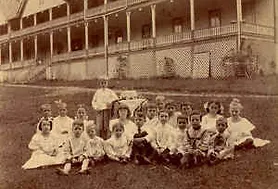
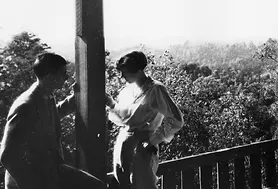
1861
With the Civil War, confederate sympathizer Lanier closed the hotel, sold it in 1863, and went back to Alabama. Subsequently there were several owners – they added a billiard hall, shooting gallery, separate ballroom, ten-pin alley, bar and croquet grounds, and a piazza for smokers – after 1868 guests could get there by train. The 1878 inventory listed 100 beds, 12 large dining tables, 12 dozen sets of table silver 175 water pitchers, 60 spittoons, and 3 billiard tables.
The hotel burned in 1896, but cottages were still available. A smaller hotel was rebuilt in 1901 – it could accommodate 100 guests. The Pflanze family bought the hotel in 1911- Ludwig Pflanze built the clay house and clay barn – and dammed the creek that created Lake Sidney Lanier. The hotel burned again in 1933. In 1947 the YMCA purchased the Montvale property for use as a summer camp; the camp closed in 2005. Now Montvale enters the next phase of its history – with the Harmony Family Center – children, families, and the community will come once more to enjoy the beauty, the mountain air, and the healing atmosphere of Montvale.
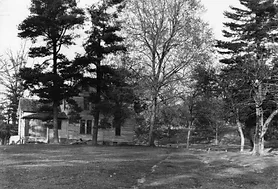
Photos compliments of the McClung Collection and The Daily Times, Maryville, Linda Braden Albert and B. Kenneth Cornett, authors of Arcadia Publishing’s Images of America book “Blount County”.



